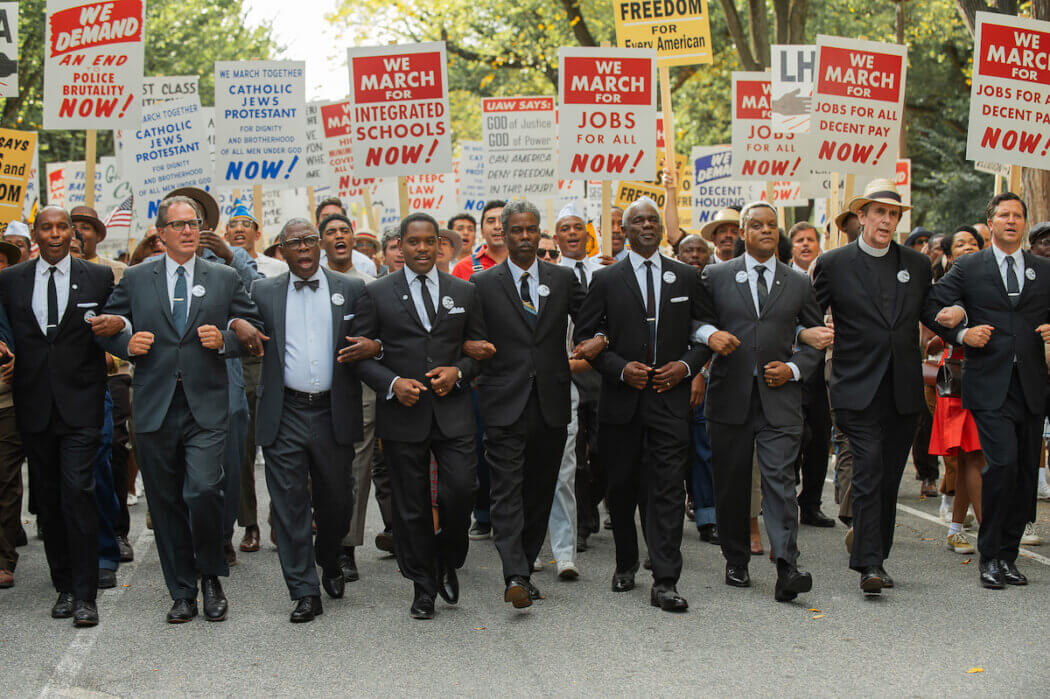Colman Domingo is having an unforgettable year. After clinching an Emmy for his standout performance in Euphoria last year, 2023 has been a whirlwind of projects. He reprised his longtime role on Fear the Walking Dead, and lent his voice to the menacing robot Unicron in Transformers: Rise of the Beasts.
Domingo is set to close the year with a powerful performance in the upcoming musical film adaptation of The Color Purple. But just before that, he embodies the outsized Bayard Rustin in the Netflix biopic Rustin, which started streaming on November 17.
The film revolves around Rustin, the mastermind behind the historic 1963 March on Washington. A close confidant of Martin Luther King Jr., Rustin faced relentless racism and homophobia while fearlessly challenging authorities, ultimately altering the trajectory of the civil rights movement.
Critics, including The Wall Street Journal, hailed Domingo as “a force of nature in this film,” while ABC News calls his performance “a thrilling acting tour-de-force.” In an exclusive conversation with Casting Networks, Domingo delved into the intricacies of portraying this influential figure.
 Photo by David Lee, courtesy of Netflix.
Photo by David Lee, courtesy of Netflix.You worked with Rustin director George C. Wolfe on the 2020 Netflix film Ma Rainey’s Black Bottom. Did you know back then George would have you playing Bayard Rustin?
Bayard is a very complex, interesting, odd, commanding, bombastic, theatrical character. I think it took George and his team a moment to really think [about] who has the abilities to reach (within) and craft this human who lives in such size, but who can also make him very grounded. Somehow, in a beautiful way, it was given to me.
Was that daunting?
Did I know if I was up for the task? I’m not sure exactly, but I knew I had the wherewithal, and I knew I had the work ethic and I wanted to figure this out. Bayard Rustin is such an important figure in our history that has been marginalized. A lot of people don’t know who Rustin is. I wanted to help figure that stuff out and make sure that it lives in a real human being and could be sustained for an entire film.
What was your early prep work on the character?
Coming from the theater, where I have a long rehearsal period, I like to work on voice and text and physical attributes that help me key into the character. Watching the way a person moves their hands can tell so much about their history – if someone holds their arms wide open, they’re fine with taking up space. That says more than a person reveals in their language.
The way Bayard spoke, his pitch was probably three octaves higher than mine, naturally. He also spoke with a Mid-Atlantic standard accent that was of his own doing. He created himself, which was awesome.
 Photo by David Lee, courtesy of Netflix.
Photo by David Lee, courtesy of Netflix.He did?
I found that out through Rachelle Horowitz, one of his dear friends. (Horowitz was 22 when she helped Rustin organize the march and was its transportation director. She is portrayed in the film by Yellowstone actress Lilli Kay) I was like, “Where’d that accent come from?” She said he made it up. He made it up!
I mean, he really was his own creation. That keys into the character. And the physicality – the way you put on some clothes from the 1960s, it changes the way you move. You don’t sit the same way or cross your legs in a certain way. Everything about that informs the character.
Rustin had a few recognizable physical traits, including some missing teeth that were knocked out by the authorities. Did wearing prosthetics in your mouth help you clinch the character?
By the time I got the prosthetics, what was interesting about that is once they go in, you still have to exist in the way that Bayard did. He smiled wide. He spoke very quickly with great elocution.
You had this barrier, this challenge here (with the prosthetics). But I knew Rustin had levity with his speech, so I had to work with that and really work with the teeth. When I smiled, I had to smile wide because he was fearless. Even though (the teeth incident) happened to him from a police attack many years ago, it didn’t stop him. It didn’t hinder him. He still smiled with fullness as if he had a full rack.
 Photo by David Lee, courtesy of Netflix.
Photo by David Lee, courtesy of Netflix.Rustin’s hair was also distinct because it was all over the place.
Most men in the 1950s and 1960s had very well-groomed hair. It was about the way we present ourselves in the world, especially as black people in America. But he was sort of a hippie, just this shocking gray hair that was a little wild, a little unkempt at times. I think that was a part of who he was. There was so much I had to access as the character that helped me inform the person walking through space. That was awesome.
Rustin is currently streaming on Netflix.
Casting directors use Casting Networks every day to discover people like you. Sign up or log in today to get one step closer to your next role.
You may also like:













